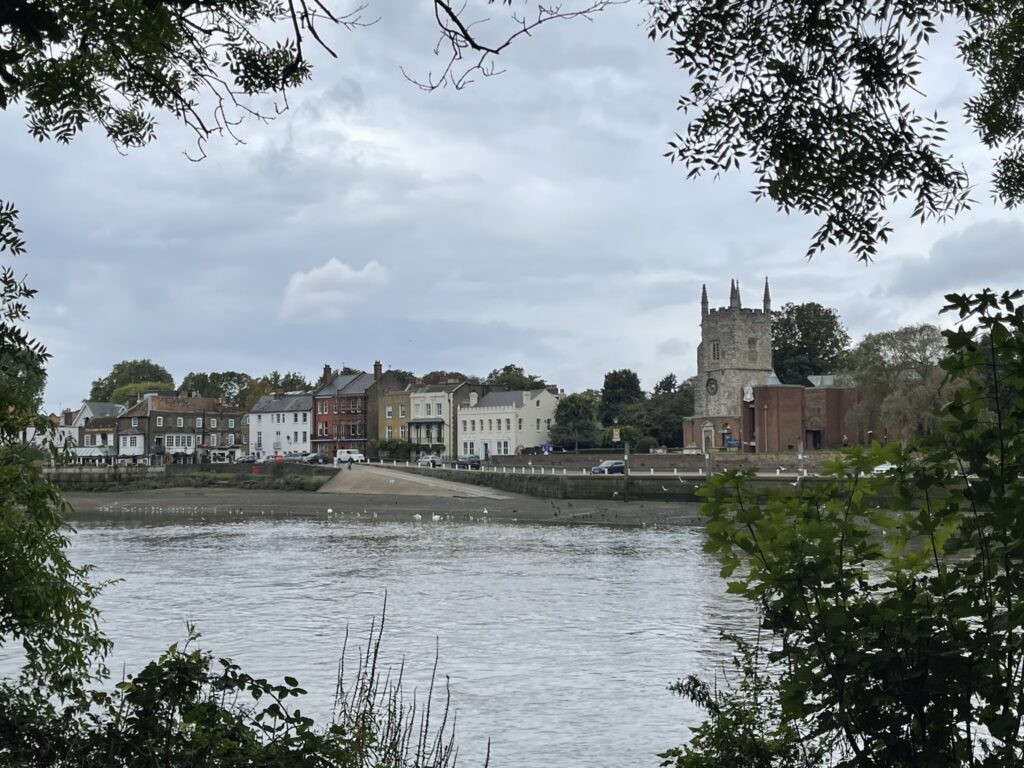Total Distance: 8 miles
Time: 3 hours 30 minutes
Points of Interest:
Kew Palace
Kew Gardens
Richmond Lock and Weir
Ham House
Eel Pie Island
Teddington Obelisk
Teddington Lock
The Half Mile Tree
Canbury Park
It was a rather chilly morning as we arrived at Kew Bridge station, but at least it was dry! We set off across Kew bridge, which was opened on the 20th May 1903 by King Edward VII and Queen Alexandra and has been grade II listed since 1983.
We continued along the south bank route of the Thames path. The first mile skirts around the edge of Kew Gardens, which houses one of the largest and most diverse botanical and mycological collections in the world. The herbarium has over 8.5 million preserved plant and fungal specimens, there are four Grade I listed buildings, and 36 Grade II listed structures, and it even has its own police force, the Kew Constabulary. The gardens opened in 1759 and is now a UNESCO World Heritage Site. If you get a chance, I highly recommend a visit.
On the edge of Kew Gardens is Kew Palace, the home of King George III and Queen Charlotte. The palace was built in 1631 and was a much larger residence. The main building that remains is the Dutch House pictured here. The palace became a refuge for George III, when he fell ill and was thought to have become mad. The seclusion of Kew, away from the public, allowed his doctors to treat him.
A little further along, on the opposite side of the river, is Syon House and Syon Park, the residence of the Duke of Northumberland. The exterior of the house was erected in 1547 and the interiors were designed by Robert Adam in 1762 under the commission of the 1st Duke and Duchess of Northumberland. The house has been used as a location for many films and series including Gosford Park, Killing Eve and Bridgerton.
Further along the path, we took our first rest stop, sitting down opposite Isleworth, which is on the north bank. Apart from the occasional aeroplane approaching Heathrow, this part of the path is so peaceful, considering that we’re still in London. It’s certainly true that a little time with nature can revive you and improve your mental wellbeing. Even in one of the busiest cities in the world, you can still find somewhere to relax and enjoy nature. Cher is also enjoying the change of scenery, being able to smell new smells and exploring the tree lined paths. These walks are doing us both some good.
After our short rest, we continued along the path, circling around the edge of the old deer park of Kew Gardens and past Isleworth Ait. We approached Richmond Lock and Weir. The lock is a grade II listed structure and was officially opened by the Duke and Duchess of York in 1894. The sluice gates ensure that the water level between Richmond Lock and Teddington Lock is maintained at or above half-tide level. It incorporates a public footbridge that, until some time during World War II, pedestrians were charged a toll of one (old) penny. Each gate weighs 32.6 tonnes and is 20 metres wide and 3.64 metres in depth.
It started to rain a bit so we picked up the pace, luckily the canopy of the trees sheltered us for a while. I must remember to bring an umbrella next time as the seasons are changing, and you can’t always rely on the weather forecast! The rain started to get heavier now, but we weren’t too far from our lunch stop at the Tide’s Table café in Richmond. This is also where I get my next stamp for my Walk the Thames passport. As we hurriedly walked towards the café, some fellow walkers stopped me and asked if I could take a picture of them. Pouring with rain, I did my best to capture a decent picture for them.
Both absolutely soaked, it was time to have a break and enjoy some refreshments. The spinach and feta quiche with Greek salad was quite agreeable, although a little pricey, but then we are in Richmond. The town derives its name from Richmond Palace, which was founded by Henry VII in the 16th Century. Queen Elizabeth I spent a lot of time at the palace as she enjoyed hunting stags at Richmond Park. She died at the palace in 1603. The palace was one of the first buildings in history to be equipped with a flushing lavatory. Not much of the palace remains, only the Wardrobe, the Trumpeters’ House and the Gate House survived, all three of which are Grade I listed.
With the rain easing and my stomach full, it was time to move on. On an ordinary dry day, it’s nice to sit here by the river and watch the world go by. Today was not that day, so we continued along the path, passing Petersham Meadows and onto Ham house.
Before we reached Ham house, on the opposite side of the river, is Marble Hill House, a Georgian villa built in the 18th Century for Henrietta Howard, later Countess of Suffolk and one time mistress of George II. The Cunard family acquired the house in 1898 for £36,000 with the intention of creating a suburban housing estate. Local opposition saved the house and after raising £70,000 the property was secured for public use in 1902.
Ham House was built in 1610 and was a gift from Charles I to William Murray, 1st Earl of Dysart and his wife Catherine. The house has remained virtually unchanged for 400 years and is internationally recognised for its superb collection of textiles, furniture, and art which have remained in the house for centuries. The property is now owned by the National Trust and is well worth a visit.
As we passed Ham House, we approached Eel Pie Island, which became quite famous in the 1960s for the number of popular music groups that played there. During a five-month period in 1963, you could see the Rolling Stones play there every Wednesday. The Who, Pink Floyd and Screaming Lord Sutch all did gigs at the Eel Pie Island Hotel, a nineteenth-century ballroom that was lost to a fire in 1971. It was a place for counter-culturalists, poets and also a hippie commune. The island now has about 50 homes on it, as well as artist studios. Although the island is private, the studios are opened up twice a year to the public.
At this point we had walked about 6 miles and Cher was getting a bit tired. I also had plans that evening so had to get home, so I decided that I would cut the walk short. The next train station was at Teddington, and I could see on the map that we could cross at Teddington Lock.
As we continued along the path, we came across the Teddington Obelisk. The Obelisk is a boundary marker marking the formal boundary of responsibility for the River Thames between the upstream reaches governed by the Environment Agency and the downstream reaches governed by the Port of London Authority. The obelisk was erected in 1909 and refurbished in 2016.
We weren’t far from Teddington Lock now. The original lock was built in 1811, but by 1827 the timber lock needed considerable repairs and the present lock was built in 1857 and opened in 1858. Footbridges were added and opened in 1889.
It took me a while to figure out how we crossed the lock, and I finally found the footbridge. However, the bridge was closed for repairs, even though the sign said it was closing at 20:00 that night!
The next train station was at Kingston, about another 2 miles further along the path. Kingston was my original destination, so something was telling me that I had to stick to my original plan! I popped Cher into her carrier and I had a rather brisk walk down to Kingston. It’s a shame I had to rush at the end, but I did quickly stop off to see the Half Mile tree. An ancient elm had stood here for 500 years until 1951 when it was felled as it was considered dangerous. It was replaced with the current elm, and it still serves its purpose of marking the half a mile to Kingston.
As we approached Kingston we walked through Canbury Gardens, a lovely riverside park, which would have been nice to sit, relax and enjoy the success of another pleasant walk along the Thames path. But unfortunately, my social calendar was calling, and I had to rush to get a train back home. I can’t believe that I have almost made it out of London! My next walk will take me into Surrey, and towards Windsor, my final destination this side of Christmas.



















